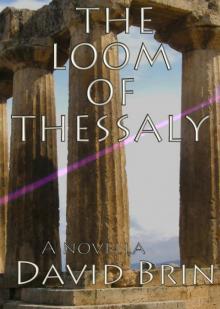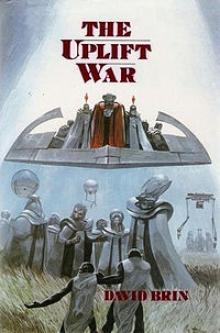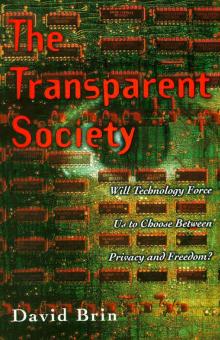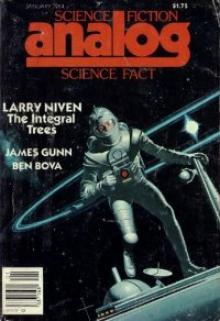- Home
- David Brin
Otherness Page 8
Otherness Read online
Page 8
Massacre in L.A.!
Tomorrow, over my protests, Helen brings in bulldozers.
Ah, Schliemann.
TUESDAY
For a time, during the Second World War, the city of Los Angeles mandated compulsory recycling. Materials of all kinds were needed for the effort, from glass and metals to paper and baking fat. Nothing is wasted when you pay heed to the true value of things. Very little refuse wound up coming to Hyperion during those years.
Then, with the war fading into memory, a candidate ran for mayor on a crowd-pleasing platform, promising to repeal the inconvenient law. He won handily. Curbside recycling ended and the trucks began rolling as never before. By the ton, by hundreds and thousands of tons. In a few years an average family might throw away a volume of material equal to their home. A new, disposable way of life seemed ordained forever.
Archaeologists could have told them. Nothing lasts forever. The Golden Age of Athens waxed and passed away again within a single human life span. So did the Age of Waste.
The world won't soon forget either.
According to the Indian Bones Act, any remains less than a thousand years old aren't specimens, but someone's ancestor. You need the local tribe's permission before digging near a burial ground, and must reinter all unearthed bones with honors.
Fair enough, but I never thought I'd see the act applied to this project. Today, while yellow machines peeled away detritus for a bigger trench, lawyers arrived with injunctions to halt the desecration of graves! Turns out they were fronting for the same bunch of retirees who tried to stop us earlier. Don't these people have better things to do with their time?
The dozers stopped for just three hours; then the stay was overruled and digging resumed. I stood around watching machines tear through layers it had taken us months to penetrate with brush and trowel. Wonderful items kept popping into view, only to vanish into hoppers and be carried away. I stopped Keoki and Les from chasing between flashing backhoe blades, plucking enticing tidbits. Without careful photography and provenance, none of it would provide useful data. So I set them to work tarping over the north end of the old trench, preserving it from contamination.
I'm making this entry with my portable. We've set up a pressurized tent and sleeping quarters, partly because work continues round the clock now, and partly because each of us has had anonymous death threats. Zola's house was vandalized, and someone fired a shot through Les's window. We voted to stay together on-site till it all blows over.
FRIDAY
Helen called off the dozers as we neared mid-fifties strata. An army of muscular cops waded in, under our direction, and soon hit bones.
And more bones! More than we can count by searchlight, all mixed in with old boxes and bed-springs, melon rinds and tea bags, newspapers and candy wrappers.
Rib cages. Vertebrae. Femurs. Grinning skulls.
Lieutenant Starling ordered a halt for coffee, to let people catch their breath. That's when word spread about The Theory. Seems the idea's been crisscrossing the Net all evening, but we hadn't heard till half the world agreed it must be the explanation.
When you think about it, none other fits! The 1950's was an era of frantic building in Southern California. Inevitably, greedy developers took shortcuts. If an old graveyard stood in the way, you were supposed to move the bodies and markers with due care, but often the whole mass was just scooped up and dumped in a pit somewhere.
And what better pit than Hyperion Landfill? A few bribes, some turned heads . . . within days layers of new garbage would hide the evidence. Besides, who was harmed?
It's remarkable how calming a good theory can be. What had verged on panic now seems placid as people wander back to work at a slower pace. There is talk of wrapping it all up tomorrow, after all.
I keep my misgivings to myself. Somehow it all seems too pat.
SATURDAY
It didn't wash. Not even for a day.
Oh, for a time headlines blared—Dump of Death Mystery Solved! Big shots came down and posed next to the bulldozers, anointing the graveyard-dumping theory and announcing that, while this had all been a nice, diverting summertime distraction, it was time to stop wasting taxpayers' money on a minor "crime" whose statute of limitations ran out before most living citizens were born. Time to let the dead rest in peace.
The old farts seemed in an awful hurry to put all this behind them. Some of the young beat reporters said their editors were hastily reassigning them. All told, things smelled pretty fishy.
We sat around pondering.
Suppose some greedy bastards did once gather up the bodies in a cemetery, trucking them off to make room for houses or a shopping mail. That's plausible. But think, what shape would the remains be in, after tumbling together in a hole? I could testify to that, having excavated ancient battlegrounds where armies of Xerxes, or Teng Ho, buried their dead in haste before the sun could rise. The skeletons here in Hyperion look nothing like those jumbled boneyards. Each one is coherent, whole, and they come spread across an area far too wide for the convenient dumping theory to explain.
We agreed unanimously. We're going back out tonight, orders or no orders.
THURSDAY
Helen Starling says her boys found the guy who set fire to my garage. I couldn't have been more surprised to learn it was old Mr. Hansen down the block! Here I'd been expecting some cabal of fundamentalist loonies to be behind the threats and vandalism against my people. But in each case it's been individual action by someone they knew. No visible connection between the perpetrators, except their advanced age. It's all very, very weird.
Haven't made a diary entry in some time. I always thought it part of being a careful scientist, like keeping good field notes. But what we're doing hasn't been science for a long time.
To recap—the bigwigs were horrified to learn we had resumed digging. While they slept, we managed to double the excavation. They then dithered, went back to their offices, made phone calls, and issued orders—and we doubled it again. By the time judges signed restraints and had them delivered, the whole chain of command lay in ruins. No cop on the beat was going to enforce a halt.
There were skeletons everywhere!
Big ones, men in their prime. Smaller ones . . . women, children . . . little babies . . .
None showed discernible traces of violent death. No sign they had ever been moved after burial. The cemetery-dumping scenario evaporated in smoke, never to be raised again.
We keep working shifts, digging, loading trucks, hauling the dross of fifty years away to the far end of Hyperion . . . though some suspect even that step might prove temporary. For the most part, we work silently, though each of us knows what ferment is crossing the airwaves. A ferment of newer, more imaginative theories.
There is talk of death squads, like they've had from time to time in South America, with vigilantes scouring the city for "undesirables" and burying their victims in the dump. Credible, perhaps, if they had killed dozens, even hundreds, but no way in the numbers we are finding. The same goes for satanic or cannibalistic cults. More colorful notions involve everything from extraterrestrial vivisections to a lost underground civilization. One fellow suggests that something about the specific gravity of bones causes them to migrate through garbage . . . though where they came from in the first place he has no idea.
My favorite idea of the current crop is spontaneous calcification. It is based on homeopathy—the notion that all objects carry the imprint of any other object that was ever in contact with them. And what did every single object in Hyperion Landfill have in common? Every one was touched countless times by human beings! Next throw in a crackpot reversal of fossilization—the process by which groundwater leaches calcium from bones and replaces it with the stuff of rock—and you've got an idea that would have surely made it to the New Age best-seller list, back in my parents' generation.
Leave trash alone long enough, and it starts precipitating out skeletons.
In other words, garbage recapit
ulates its makers. We are what we waste.
A fine, maniacal notion. I don't dismiss it lightly.
Or are they metaphors? Perhaps guilt festers and makes tangible a city's crimes.
What, after all, did we do to the homeless, the forgotten? Those spilled out of mental hospitals to fend on their own? In effect, we threw them away. The malnourished, the ill educated, the drug racked and brain wounded. We threw out all the possibilities they might have brought to light with strong hands and minds, just as surely as those big trucks carried off all else inconvenient and disposable.
I look back on Persia, China, India . . . wherever I dug and found middens of bones, thinking them burial grounds of real people. Perhaps the same thing happened there, as well! In each culture shame may have leaked from the living, seeping underground to wherever lost hopes go, congealing into hideous shape within the ground. . . .
No, no! I have felt the bones in my hands. They are real, stretching away in all directions. They were once draped in flesh, I know it.
People are welcome to their crackpot theories. But all metaphysics aside, something happened here. Something terrible.
SEPTEMBER
Nobody is bothering with police cordons anymore. Everyone and anyone is welcome to come up to Hyperion, to help dig. Sometimes it seems half the population under fifty must be here, assisting with the excavation, browsing through the detritus, carting things away. It looks like a scene from some fantastic D. W. Griffith epic about the construction of the pyramids, only on a vaster scale. Here, under only the loosest of direction, a mob, a horde, a civilization labors amid dust and stink to undo the greatest single edifice built by their ancestors, taking it apart by hand and hauling the bits off in trucks, cars, wheelbarrows.
What our grandparents created here—what they buried—is fast growing apparent, and they don't like it. They wander among us, old folks, confused, distracted, grabbing us by the sleeve and begging us to stop. When questioned, none of them can explain why. Tearfully, they just say that it's wrong. That we must leave it be.
It's the same with officials, politicians, judges. The eldest issue pronouncements, file writs. We ignore them and dig on, uncovering layer after layer of the dead.
A million skeletons so far, with no end in sight.
Reports come in from other cities. Of landfill boneyards in New York, Atlanta, Seattle . . . though none as extensive or dating so far back as Los Angeles. Perhaps that means it happened first and most profoundly here, in L.A.
But what? What happened here? Whence came the dead?
Zola claims that the skulls are different from ours. She points to a slight, statistical difference in the shape of the occipital lobe.
"They were more like Neanderthals than we are," she says, with the eagerness of a proselyte. "They would have been more intuitive, more empathic beings. . . ."
Les and I think all this must have driven her over the edge. None of us can see any difference worth getting excited over.
On the other hand, maybe we don't want to see. Any difference that held true would support the scariest theory—that we are all murderers.
That we're invaders.
That the true, rightful denizens of L.A. lie buried where our grandparents put them, after slaying them, one by one. In the course of taking over their city, their lives.
The fact that the idea comes straight out of classic sci-fi doesn't repudiate it. The paranoiac films of those days may reflect an instinctual terror felt by those who saw no difference in their friends and family, but somehow knew them for replacements, doppelgangers. Somehow knew their own turn was coming.
It might explain why old folks act the way they do. Deep inside, at some inner core, they are still aliens. Long ago they adopted the memories, behavior, attitudes of the Angelenos they replaced—becoming passionate Democrats, Republicans, junkies, and Zen Buddhists—while deep down part of them still knows what they were.
But we, their descendants, were born thinking ourselves human, if a bit strange for living in this bizarre city. We grew up glorying in quirky ideas—wild individuality, diversity, cool—and most of all the novel notion that "weird" is no four-letter word.
If someone killed two million Angelenos, our first instinct is pure, ironic.
To avenge them.
OCTOBER
There is another theory. We might simply have thrown them all away.
The bodies, I mean.
Just the bodies.
They were ours, and we exchanged them. Traded them in. Got new models. Threw out the old.
Why not? It suits our style. Despite all the conservation laws passed for harder times. Despite draconian recycling. Despite a soaring cost of living caused by wastrel days, we still think basically the same. Like magpies, we'll try whatever's shiny, new.
What if someone once made our grandparents an offer they couldn't refuse?
"Sign here, and I'll show you how to molt and be reborn livelier, more interesting people! Do this and your city will soar heights, explore depths, no other has ever known. Only in order to trade up, you must forget this pact. Forget the husks you shed. Toss them into the trash along with this week's newspapers, detergent boxes, TV-dinner trays! Toss them out, and live!"
I wonder about the fine print. Would Angelenos even stop to read it, in their rush to sign?
I also wonder if I'm going mad.
WINTER
Hyperion is deep . . . deeper than we ever imagined. Yet, slowly, inexorably, it empties itself of all we had put there.
Where the detritus is taken, I don't know. Only that it climbs a hundred trails out of this valley, by machine, by human back, sometimes in a floating haze that seems to scale the dusty hills without aid. Like a superfluid—like some entity awakened—the waste departs, spilling from a container unable to hold it any longer.
Our dross, our toys, our broken machine servants, our used wrappers . . . how could we ever think the bonds linking us to our things could be broken simply by throwing them away? Destiny firmly connects the maker and the made. User and used. Creation and creator. So it was in the myths of Ur and Thebes. So it always shall be.
We never really threw our things away. We just put them down for a while.
Now they are coming home.
MILLENIUM
Picked clean, it holds a certain sterile beauty. A valley of bare, trampled clay between steep hills. Bare clay covered with four million skeletons, the only man-made things now left behind.
It makes a pretty scene—Hyperion Boneyard. Peaceful.
All the hordes are gone. Just a few of us remain, sitting around, waiting.
Things are happening just over the rim, where Los Angeles can be heard fast turning into something different again. By now one theory or another must have proved true. Or else no one cares anymore about past truths, so involved are they in rapid changes. Merging the reclaimed into what's shiny new. But some of us stay in Hyperion, fed from time to time by kindly visitors. We wait, keeping vigil for others who cannot.
Sometimes it rains. Bones sink slowly into the softening mud.
Full of nutrients, I hear. Bones are. They belong in good earth.
Yesterday I thought I saw a condor, winging near the sun.
Yes, yes. I know things are going on elsewhere. I'll go take part again, really. Soon as I've rested. Thought a few things out. Seen events through to their conclusion.
I'll just stay a little while longer . . . and watch the first oaks grow.
The Dogma of Otherness
It all began when my publisher sent me out on what used to be called a Chautauqua circuit—public seminars and panels and rubber-chicken dinners—to promote my books. That's when I began noticing something very strange about the way people have started thinking these days.
Publicity tours can be pretty tedious at times. Even science-fiction conventions start to blur after too long an exposure. Maybe that's why I started seeing things I otherwise would have ignored.
It started i
nnocuously enough: my second novel was about genetically engineered dolphins, and its no secret that—next to unicorns—those friendly sea mammals are just about everybody's favorite creatures. People at these gatherings seemed mostly to like the way I handled them.
Inevitably, though, someone in the crowd would ask what I think of porpoise intelligence here and now, in the real world.
It's predictable. There is something compelling about a species that so obviously (for lord knows what reason) likes us. People want to know more about them. They ask how much progress has been made in teaching dolphins to speak our language. Or have researchers yet learned to talk to them in theirs?

 The Practice Effect
The Practice Effect Infinity's Shore
Infinity's Shore Insistence of Vision
Insistence of Vision Sundiver
Sundiver Brightness Reef
Brightness Reef Existence
Existence The Transparent Society
The Transparent Society Startide Rising
Startide Rising The Postman
The Postman The Uplift War
The Uplift War The Loom of Thessaly
The Loom of Thessaly Otherness
Otherness Sundiver u-1
Sundiver u-1 The Uplift War u-3
The Uplift War u-3 Infinity's Shore u-5
Infinity's Shore u-5 Brightness Reef u-4
Brightness Reef u-4 Uplift 2 - Startide Rising
Uplift 2 - Startide Rising Kiln People
Kiln People Heaven's Reach u-6
Heaven's Reach u-6 The Transparent Society: Will Technology Force Us to Choose Between Privacy and Freedom?
The Transparent Society: Will Technology Force Us to Choose Between Privacy and Freedom? Star Wars on Trial
Star Wars on Trial Lungfish
Lungfish Tank Farm Dynamo
Tank Farm Dynamo Just a Hint
Just a Hint A Stage of Memory
A Stage of Memory Foundation’s Triumph sf-3
Foundation’s Triumph sf-3 Thor Meets Captain America
Thor Meets Captain America Senses Three and Six
Senses Three and Six The River of Time
The River of Time Chasing Shadows: Visions of Our Coming Transparent World
Chasing Shadows: Visions of Our Coming Transparent World Foundation's Triumph
Foundation's Triumph Startide Rising u-2
Startide Rising u-2 The Fourth Vocation of George Gustaf
The Fourth Vocation of George Gustaf The Heart of the Comet
The Heart of the Comet The Crystal Spheres
The Crystal Spheres